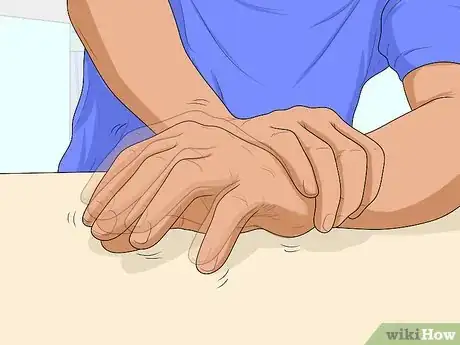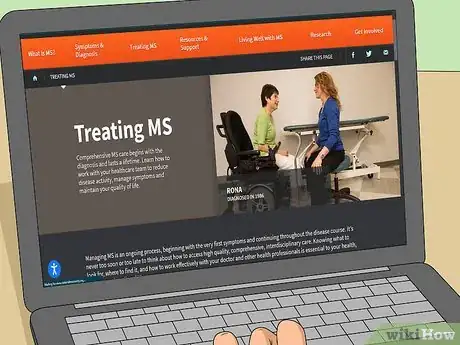This article was co-authored by wikiHow Staff. Our trained team of editors and researchers validate articles for accuracy and comprehensiveness. wikiHow's Content Management Team carefully monitors the work from our editorial staff to ensure that each article is backed by trusted research and meets our high quality standards.
There are 16 references cited in this article, which can be found at the bottom of the page.
This article has been viewed 35,201 times.
Learn more...
Multiple sclerosis (MS) is an autoimmune disease of unknown cause that affects the central nervous system. It is estimated that over 2.3 million people worldwide are affected by MS,[1] with most people being diagnosed between the ages of 20 and 50.[2] MS symptoms vary from person to person, with some experiencing a variety of symptoms and others very few. Recognizing both the common and rarer symptoms of MS can help you seek out a diagnosis.[3]
Steps
Identifying Common Symptoms of MS
-
1Keep track of feelings of exhaustion. Keep a daily journal and take note of the specific times of the day when you feel fatigued. Fatigue is one of the most common symptoms of MS, with 80% of people with MS experiencing fatigue and lassitude. Lassitude is a severe type of MS-related fatigue and manifests itself in the following ways:[4]
- Fatigue typically occurs on a daily basis.
- Fatigue is exacerbated by heat and humidity.
- Fatigue onset can occur early in the morning, even after a good night’s sleep.
- Fatigue interferes with daily activities.
-
2Look out for numbness. One of the first symptoms of MS is numbness or tingling of the face, arms, legs, or body. If you experience numbness, consult a doctor immediately. While this is a symptom of MS, it is also a symptom of other conditions which may require urgent treatment.[5]
- This numbness could range from mild to severe.
- If you experience severe facial numbness, take extra precautions when eating or chewing, since you may accidentally bite your tongue. If you experience severe numbness in other parts of your body, be careful around sources of heat, like fires or boiling water.
Advertisement -
3Watch out for dizziness or vertigo. With MS, you may feel lightheaded or feel like the room is spinning around you. However, conditions other than MS, like a middle ear inflammation, could cause these symptoms. Consult with your doctor for proper diagnosis.[6]
-
4Notice any mood changes. The pain and distress associated with MS can lead to persistent anxiousness or extreme irritability.[7]
- Depression is another common symptom of MS. If you suspect you may be depressed, be it because you feel down, hopeless, or have little interest in doing things, visit the Mental Health America website at [1] for a free depression screening.
-
5Take note if you have any vision problems. These could range from blurry vision to pain when moving your eye to double vision or vision loss due to optic neuritis. There are different management approaches for each of these vision symptoms, so check with your doctor for the appropriate course of action to take.[8]
-
6Keep an eye out for forgetfulness or difficulty focusing. MS can cause cognitive changes. These changes are the first symptom of MS for many individuals affected by the disease. You may experience foggy memory, difficulty processing information and concentrating, slowed verbal fluency, or difficulty retaining new information.[9]
-
7Know about other common symptoms. Some symptoms of MS typically arise in the latter stages of the disease. These include muscle weakness and sexual, bladder, or bowel problems.[10]
Recognizing Less Common Symptoms of MS
-
1Be aware of any speech problems you may develop. You (or others) may notice that you take longer pauses between words or individual syllables. This is known as scanning speech. You may also notice that you slur words or speak nasally, as if you had a cold. These could all be symptoms, however rare, of MS.[11]
- A speech or language pathologist can often help overcome these speech problems.
-
2See a doctor if you have uncontrollable shaking. This is otherwise known as tremor and can manifest itself multiple ways:[12]
- When moving. This type of tremor, known as an intention tremor, worsens when you try to reach for or grasp something or when you try to move your hands or feet to a particular spot.
- When supported against gravity. For example, if you are sitting, you may experience this type of tremor, known as a postural tremor.
- When the body is at rest. This is known as a resting tremor.
- Jumpy eye movements. This is known as nystagmus.
-
3Notice any hearing loss. Acute episodes of hearing deficit have been reported by people with MS. However, hearing loss is rarely associated with MS, so consider having your hearing evaluated to rule out other potential causes.[13]
-
4Seek help if you have a seizure. These could take the form of episodes of unconsciousness with jerking movements of the extremities, bouts of unconsciousness without jerking movements, or being unable to respond to external stimuli despite appearing awake. Seizures only occur in about 2-5% of people with MS.[14]
Diagnosing and Treating MS
-
1See your doctor. Make an appointment with your doctor if you are experiencing symptoms that resemble MS. Your doctor can recommend the next steps and, if need be, make an MS diagnosis.[15]
- Don’t wait to make an appointment. Seeing your doctor sooner rather than later means you can start any necessary treatment earlier. This may help alleviate your current symptoms.
-
2Get tested. Arriving at an MS diagnosis involves using specific tests to rule out other diagnoses. A diagnosis of MS typically involves blood tests to rule out other conditions and an MRI to obtain detailed images of the brain and spinal cord. Your doctor might also suggest a lumbar puncture and/or an evoked potential (EP) test.[16]
-
3Review your treatment options. Different medications are used to manage the symptoms of MS, modify the disease course, and treat relapses. Your doctor may prescribe symptom-specific medication.[17] To learn more about medications typically used to treat specific symptoms, visit the National Multiple Sclerosis Society website.[18]
Warnings
- See your doctor immediately if you experience any MS-like symptoms.⧼thumbs_response⧽
References
- ↑ https://www.ncbi.nlm.nih.gov/pmc/articles/PMC6942519/
- ↑ https://medlineplus.gov/multiplesclerosis.html
- ↑ https://www.nhs.uk/conditions/multiple-sclerosis/symptoms/
- ↑ https://my.clevelandclinic.org/health/diseases/17248-multiple-sclerosis
- ↑ https://medlineplus.gov/multiplesclerosis.html
- ↑ https://health.clevelandclinic.org/4-early-signs-of-ms-you-shouldnt-ignore/
- ↑ https://www.hopkinsmedicine.org/health/conditions-and-diseases/multiple-sclerosis-ms/multiple-sclerosis-and-mental-health-3-common-challenges
- ↑ https://www.msif.org/about-ms/symptoms-of-ms/vision-issues/
- ↑ https://my.clevelandclinic.org/health/diseases/14455-multiple-sclerosis-ms-impaired-cognition
- ↑ https://www.nhs.uk/conditions/multiple-sclerosis/symptoms/
- ↑ https://www.nationalmssociety.org/Symptoms-Diagnosis/MS-Symptoms/Speech-Disorders
- ↑ https://www.nationalmssociety.org/Symptoms-Diagnosis/MS-Symptoms/Tremor
- ↑ https://www.nationalmssociety.org/Symptoms-Diagnosis/MS-Symptoms/Hearing-Loss
- ↑ https://www.nationalmssociety.org/Symptoms-Diagnosis/MS-Symptoms/Seizures
- ↑ https://my.clevelandclinic.org/health/diseases/17248-multiple-sclerosis#diagnosis-and-tests
- ↑ https://www.nhs.uk/conditions/multiple-sclerosis/diagnosis/
- ↑ https://www.nhs.uk/conditions/multiple-sclerosis/treatment/
- ↑ https://www.nationalmssociety.org/Treating-MS
























































Medical Disclaimer
The content of this article is not intended to be a substitute for professional medical advice, examination, diagnosis, or treatment. You should always contact your doctor or other qualified healthcare professional before starting, changing, or stopping any kind of health treatment.
Read More...